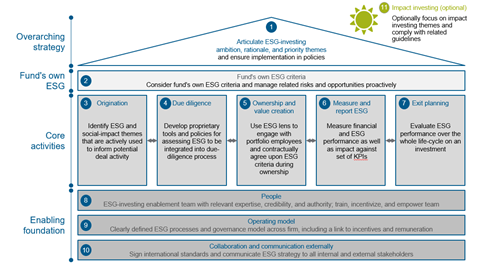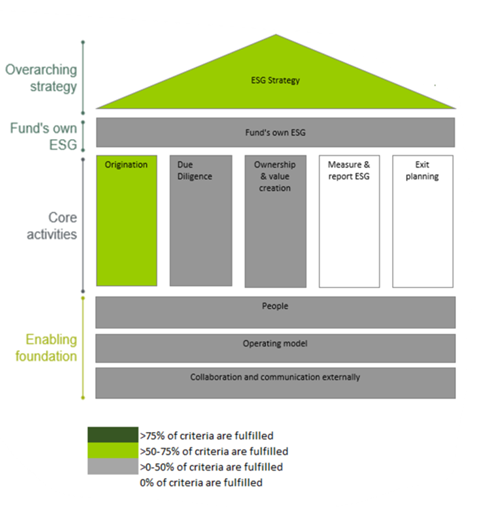Signatory type: asset owner
HQ country: Germany
KfW Capital is a subsidiary of KfW Group and invests in German and European venture capital and debt funds. We also engage with stakeholders to develop common standards and participate in initiatives such as VentureESG to encourage the industry to view ESG incorporation as non-negotiable.
Why
The venture capital ecosystem requires a special sustainability framework to account for innovative business models and the early-stage and resource-constrained nature of start-up companies. As a result, we have established our own processes and frameworks to conduct exhaustive ESG due diligence and have appropriate discussions with European venture capital fund managers.
We want to invest in managers that identify and manage major ESG risks and opportunities as this contributes to the enduring success of enterprises. We also aim to consider sustainability aspects alongside our financial performance objectives when making investment decisions or recommendations.
We expect managers to consider the possible negative effects that can result from enterprises and their activities, particularly as part of appropriate risk management, as these can have a substantial impact on the investment value and, thus, on our risk-return profile and reputation as an investor.
How
We developed a comprehensive ESG framework with the Boston Consulting Group and have been integrating it into our standard investment process since early 2021.
In most cases, the venture capital funds we invest with have a blind capital pool or partial portfolio when we make our commitment. We therefore analyse the fund manager’s capabilities and processes to understand whether it implements an ESG management strategy and associated processes appropriately, and how it does so, taking into account its size and strategy.
As a first step, we ensure that the fund does not contravene any of our exclusion list criteria. This list expands on KfW Group’s exclusion list by covering areas that are particularly relevant to venture capital, including cryptocurrencies and gene editing technologies. We also expect a fund to have a formal sustainability policy that is accessible to all employees.
As part of our due diligence, we use a standardised and quantified ESG questionnaire. Each question offers four response options that describe a manager’s ESG capabilities (see Figure 1). Respondents choose the description that best fits their current level. The levels are deliberately ambitious so that the respective fund can set development targets.
Figure 1: Example questions from the KfW Capital ESG questionnaire
| Question | Answer possibilities | |||
|---|---|---|---|---|
|
1 |
2 |
3 |
4 |
|
|
What type of ESG strategy is the fund following? Please describe the strategy in the comment field |
No ESG strategy in place |
ESG strategy focuses on negative screening to disregard certain companies based on their performance |
ESG strategy focuses on ESG as risk management approach to improve risk-adjusted returns |
ESG strategy focuses identifying opportunities and growth potential and is part of the investment decisions |
|
How mature is your ESG policy? |
No ESG policy in place |
Written ESG policy in place with clear information on the goal and strategy of ESG integration |
Written ESG policy in place with clear information on the goal and strategy, process and practices, responsibilities within the investment process AND within the fund itself |
Written ESG policy in place with the characteristics of level 3 and additional information on sector or fund specific ESG criteria, clear goals/KPIs; covering the whole investment process; being reviewed regularly and adapted accordingly |
|
Does your company have clear KPIs regarding D&I? |
No KPIs set |
Few KPIs in place, mostly qualitative / input focused (e.g., based on activities done) |
Comprehensive set of quantitative KPIs for measuring D&I outcome (e.g., increase in proportion of women) that are tracked sporadically |
Comprehensive set of quantitative KPIs for measuring D&I outcome with regular tracking system across the company and regular reporting |
We summarise the results in what we call the ESG Capabilities House (see Figure 2).
Figure 2. The ESG Capabilities House

By doing so, we obtain a detailed picture of a fund’s existing ESG integration efforts into its investment processes, fund and corporate structure.
Our questionnaire also goes beyond specific ESG criteria to assess social, environmental and economic effects (the impact) generated by the fund and its portfolio companies.
We rate funds on a scale from 0% to 100% in each dimension:
- A score of 0% to 50% in any dimension means that the fund selected answers at levels 1 or 2, on average, and that their ESG capabilities are immature and not well developed for this particular aspect.
- A score from 51% to 75% in any dimension means that, on average, funds selected answers in levels 2 and 3, indicating that they are beginning to develop their ESG capabilities and the fund is starting to benefit from this.
- A score from 76% to 100% (an average of levels 3 and 4) indicates that funds integrate ESG processes deeply into a specific area, giving them a clear competitive advantage.
Our investment, risk and sustainability management teams will evaluate a fund based on the rating it is given. We discuss the completed questionnaire and all relevant fund materials (in-house ESG questionnaire, policy, onboarding material and reporting tools, if available) with the fund’s ESG and investment personnel to qualify the results.
When we identify areas for further development or if the fund does not have a sustainability policy yet, we discuss this as well and suggest improvements.
For critical cases we seek to add action plans to our side letters in case the issue(s) cannot be resolved prior to finalising an investment.
Our side letter includes the following, if these are not already outlined in the Limited Partnership Agreement:
- our exclusion list;
- a requirement for funds to:
- provide an ESG policy
- report on ESG and impact figures
- adopt or develop best practices – where reasonably possible – based on global international standards, such as human rights, international labour rights and product safety.
Example
Figure 3 shows how one of our venture capital funds initially scored in our ESG due diligence recently.
Figure 3: Example Capabilities House for reviewed fund

According to the questionnaire, the fund had integrated ESG considerations at levels 2 and 3 in its strategy. Although it considered ESG risks and opportunities when identifying potential investments, they were not key criteria – rather, they were considered as an add-on, when proactively mentioned in company pitches. The fund conducted negative ESG screening at the beginning of its investment due diligence without using a standardised and comprehensive ESG questionnaire. It had an ESG policy but this could be improved, as reflected in the ad-hoc nature of its ESG integration practices.
To further assess these gaps and specify areas of improvement, we discussed the fund’s investment process and internal actions in detail during our investment decision-making process.
Following this, we communicated a clear list of expectations to the fund, asking it to:
- improve its ESG policy;
- develop a robust questionnaire and reflect the outcomes in the investment proposal; agree on action plans where necessary;
- start establishing a reporting and monitoring scheme; and
- strengthen its organisational ESG activities (e.g. hiring practices, internal policies).
To support them in this process, we acted like a sparring partner – by providing suitable academic background papers for guidance, an indicative structure for a comprehensive ESG policy (based on the categories of the Capabilities House) and relevant indicators for an ESG questionnaire they could use in their investment process (based on the results of our ESG heatmap[1]). We also introduced them to another portfolio fund that already has a good ESG risk assessment process and reporting tool in place.
Before finalising the investment, we reviewed and commented on the fund’s newly drafted ESG questionnaire and amended policy.
As well as improving its investment process, the GP plans to establish internal measures to reduce its carbon footprint (by reviewing its travel policy and employee transport provision and sourcing a carbon accounting tool provider) and to promote diversity in the venture capital ecosystem (by becoming certified by Diversity VC and supporting a female founder accelerator).
To ensure that the processes are actively integrated and to monitor the improvements these will yield, we have agreed on a catch-up meeting by the end of 2022.
References
[1] As part of our ESG integration approach, we developed an ESG Heatmap – designed to identify the material factors within a range of ESG criteria that could affect a start-up’s financial performance and, as a result, that of the fund itself. For more detail, see Growing the Seeds of ESG: Venture Capital, Start-Ups, and the Need for Sustainability












